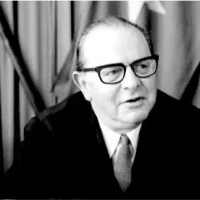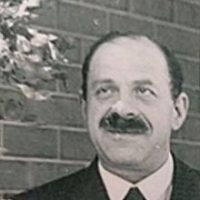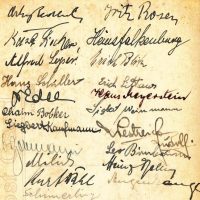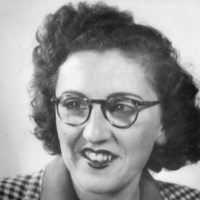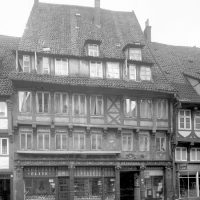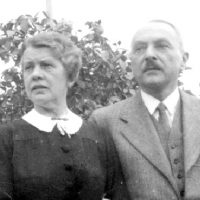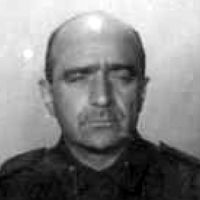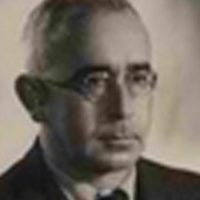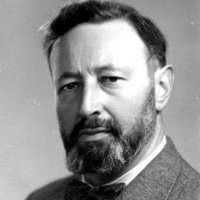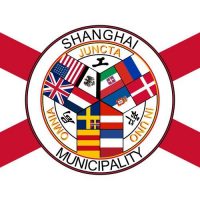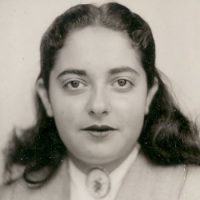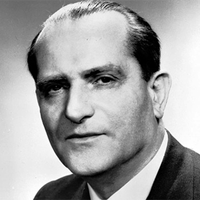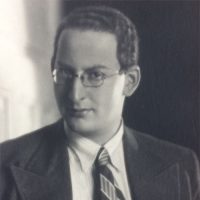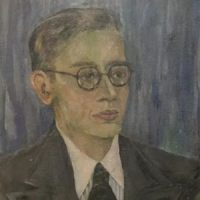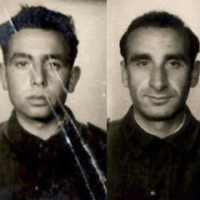A superficial memory connects the author with the paediatrician Dr Ernst Ludwig Wasser. Sometime in the early 1960s, I was probably not even ten years old and once again had a cold. I still don’t know why my father took me from Steglitz across what was then West Berlin to Dr Ernst Wasser’s paediatric practice in Zehlendorf. What is clear is that I didn’t like the long journey in the cold season with multiple changes. I also didn’t feel particularly comfortable in the overheated waiting room with nagging children. On top of that, I don’t remember the examination, the diagnosis or the treatment, let alone what the adults may have discussed “on the side”. Nevertheless, decades later, my memory brought the paediatrician’s name back to the surface and the results of my initial research were surprising. However, it is not known where the two met for the first time in their lives.
Peter Dehn January 2024. Updated December 2024.
As a pediatrician in Berlin and Schneidemühl
Ernst Ludwig Wasser[1] Birth entry no. 84 from March 28, 1893. was born on March 23, 1893 in Züllichau (today Sulechów, Poland). His parents are the lawyer and notary Albert Wasser[2] Registry office Charlottenburg, death entry no. 563 from Feb 21, 1920. (1857-1920) and Rosa Friedländer[3] Registry office Charlottenburg, death entry no. 1872 from Seo 30, 1914. (1865-1915), who was born in Posen[4] Today a neighbourhood of Neustadt/Orla, Thuringia.. Ernst’s older sister Elfriede[5] Birth entry no. 164 from Juli 4, 1890. was born in Züllichau on July 2, 1890; she was deported from Berlin to Auschwitz[6] Cf. Mapping the Lives about Elfriede Wasser, retrieved May 12, 2023. on January 29, 1943 and murdered there.
Ernst Wasser studied medicine in Heidelberg and Berlin from 1913 to 1920. His studies were interrupted by military service[7] Cf. National Archives of Australia (NAA), NAA_ItemNumber9907366. for the German Empire from 1914 to 1919. Among other things, he is awarded the Iron Cross[8] This medal is still in the family's possession today. Conversation with granddaughter Ursula Welch, 8.11.2024. 1st class. From 1921 to 1923, he was employed as an assistant doctor at the Municipal Children’s and Mothers’ Home in Berlin-Charlottenburg and in the First Surgical Department of the Berlin-Westend Hospital.[9] Cf. Information about the Wasser family on www.ancestry.de, retrieved April 18, 2023. He lived a short distance away at Danckelmannstraße 32[10] Adress book Berlin, 1920 edition..
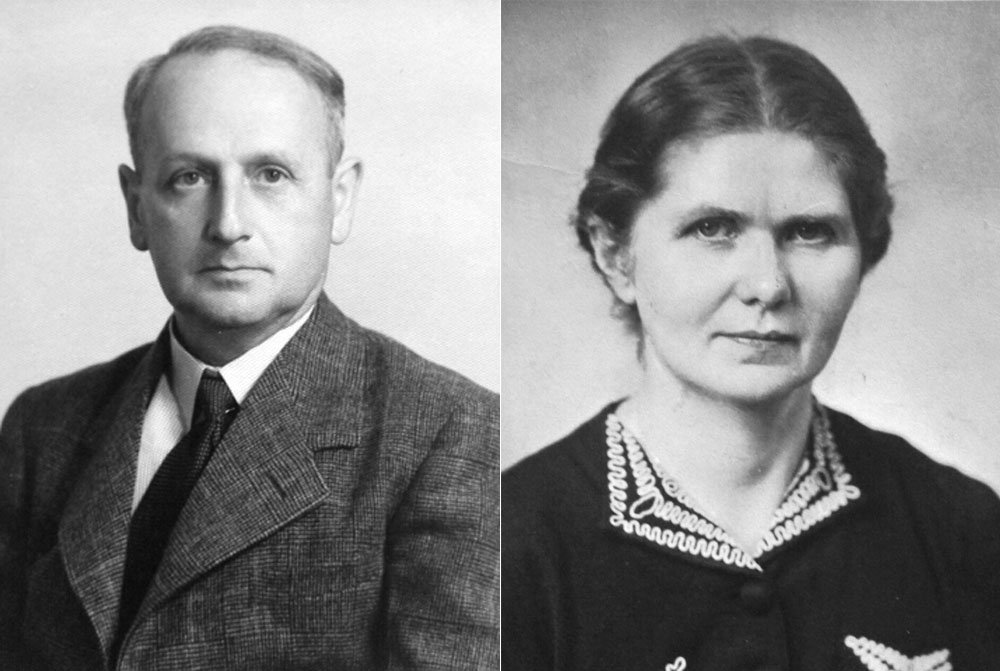

On September 15, 1921, Ernst Wasser and Annemarie Martina Sochatzky[11] Marriage entry Königstein/Taunus no. 21 from Sep 15, 1921., born on September 27, 1897 in Finsterwalde, married. They had two daughters: Anne Rose[12] Cf. Information about the Wasser family on www.ancestry.de, retrieved April 18, 2023. was born on August 17, 1922 in Berlin, where she died on March 4, 2012. Brigitte[13] Ibid. was born on January 14, 1924 in Schneidemühl[14] Wikipedia about Pila, retrieved May 15, 2023. (today Piła, Poland); she died in Brazil in 2010. After their wedding, Annemarie and Ernst moved to Königsweg 11[15] White pages Berlin 1921 edition. (today Wundtstraße).
In 1923, Dr. Wasser is licensed as a specialist in paediatrics and founds a specialist paediatric practice in Schneidemühl then the capital of the Posen-West Prussian province. According to contemporary witnesses, the practice is located on the second floor of the house on the corner of Zeughaus and Posener Straße[16] Cf. Charlotte Rink on Pila.pl, retrieved May 12, 2023. (today Maja and Sródmiejska).
In 1936, targeted personal racist persecution began against Dr. Wasser and his family. The Gestapo carried out house searches and confiscated the patient files. Dr. Wasser’s Protestant wife Annemarie was also interrogated. However, she refuses to sign a “protocol” that would have seriously incriminated her husband. As a result, the Gestapo took him into “Schutzhaft[17] Mapping the Lives about Ernst Wasser, retrieved May 12, 2023.” (protective custody) from July 1 to October 31, 1936 for alleged “preparation for high treason”. A distant relative and Nazi helped to get the pediatrician out of there, the relatives report. However, this was done in return for an express promise never to contact him again.
Denunciation as a competitive weapon
Dr. Wasser is not a devout Jew, reports granddaughter Ursula Welch. However, the Nazis were not interested in this. Under Nazi injustice, his daughters are considered half-Jewish. Tens of thousands whose Jewish origins they claimed were expelled from Germany. Their property is expropriated to finance the planned war.
The family assumes that Schneidemühl’s only other (and “Aryan”) pediatrician wanted to force his Jewish competitor out of business. By denouncing him, the latter may have ensured that the Gestapo banned Ernst Wasser from practicing his profession on May 11, 1938. The Gestapo, “in its efforts to prohibit my grandfather from practising, was also supported by the only {sic!] Schneidemühl’s only pediatrician colleague”. Nevertheless, many families continued to show their trust in Dr. Wasser. They sought advice and help for their children from him – now in complete secrecy “disguised as a visit or late at night so as not to be seen”, according to the DGKJ publication.

The Wassers’ home in Schneidemühl, Albrechtstrasse 27 (today: Ul. Stefana Okrzei) was also the location of his practice. Photo: Welch archive.
The next stage of Dr. Wasser’s life is his stay at the Jewish institution Landwerk Neuendorf[18] Wikipedia about Landwerk Neuendorf, retrieved May 12, 2023. near Fürstenwalde, east of Berlin. In this “Hachshara” camp, Jewish youths are trained in agricultural work to prepare them for life in Palestine. Later, the future TV entertainer Hans Rosenthal and the singer Esther Bejarano also lived there. The SS raided the school in November 1938. In the course of the mass arrests of Jews shortly after the pogroms of November 8 and 9, 1938 they deported staff and pupils[19] Gutshof mit Geschichte, retrieved June 17, 2023. to Sachsenhausen concentration camp as Aktionsjude. Ernst Wasser was imprisoned there until December 20, 1938 with the prisoner number 12246[20] Mail of Sachsenhausen memorial to P. Dehn, from July 7, 2022. and in the “Jew” category in hut 40.
Faced with the impossibility of earning a living for himself and his family and the general climate of threat against Jews, the Wasser family tried to emigrate to Brazil. Annemarie and daughters Brigitte and Anne Rose are not Jewish; they obtain visas for Brazil and leave Nazi Germany in April 1939. Ernst Ludwig Wasser is branded a Jew by the “J” stamp in his passport and Brazil refuses him entry. Were Jews not wanted there? Ernst Wasser’s last known German address was Am Hegewinkel 108[21] Mapping the Lives loc.cit. in the Berlin district of Zehlendorf.
As “fifth column” in British internment
The “Hilfsverein der deutschen Juden” enabled around 2,500 out of 10,000 applicants to leave the country. This enabled men to escape to England who were considered to be particularly at risk due to imprisonment in a concentration camp and the forced departure associated with their release. The use and operation of Kitchener Camp[22] For the background and history of the Kitchener Camp, see Clare Ungerson "Four Thousand Lives. The Rescue of German Jewish Men to Britain, 1939". The History Press, Cheltenham 20014/2019. near Richborough in the county of Kent is financed exclusively from donations collected by Jewish organizations after the pogrom night. It is intended as a transit camp – because many refugees want to travel on to relatives or friends in other countries, but need time and accommodation to obtain visas etc.
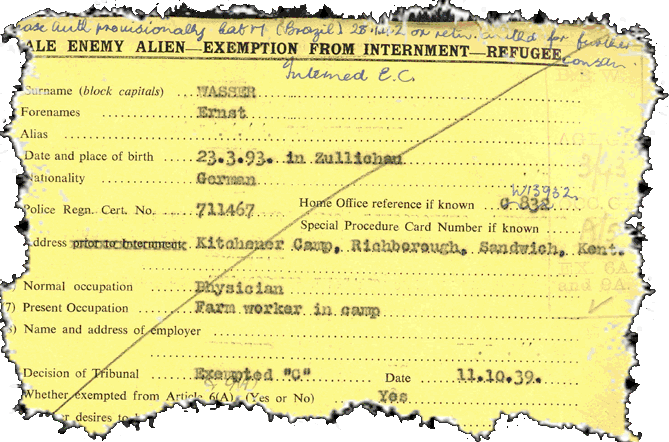
Ernst Wasser arrives in Dover on May 23, 1939[23] Route sheet of the German Jewish Aid Committee for Dr. Wasser. and travels on to Kitchener Camp, around 24 km to the north. On October 11, 1939, the domestic intelligence service MI5 has Exempted ‘C'”[24] Index Card of Home Office via ancestry.de. noted on his file card. Dr. Wasser is thus recognized as a refugee and Nazi victim and exempt from internment measures.
The camp is located near the exit of the English Channel into the North Sea and close to the coast. Due to the feared attack on England by the Nazi Wehrmacht following the defeat of France, it took on a new strategic importance for the British military. From May until July 1940, the internees were therefore transferred to other camps. The military took over Kitchener Camp in excellent condition.
Ernst Wasser, Heinz Dehn und 600 other internees are distributed to several camps on the Isle of Man[25] Heinz Dehn in the compensation proceedings before the Landgericht Berlin, file no. 191.0 (Entsch.) 421/74.. Many refugees are held captive behind barbed wire and in houses “furnished” only with straw sacks. Tens of thousands of refugees who escaped the Nazis as Jews or political opponents are now insulted in England – including by the new Prime Minister Winston Churchill – as a potential “5th column of Hitler”. Britain wants to get rid of them and deports more than 11,000 men overseas. Canada and Australia are paid to house[26] Cf. Paul R. Bartrop, Gabrielle Eisen „The Dunera Affair“, Melbourne 1990. Chapter 1 documents numerous documents on the negotiations with Australia. internees and prisoners of war.
After her emigration, Annemarie Wasser kept up a lively correspondence with family and friends. She received many letters back later. Her daughter Anne Rose Wasser read them onto cassette tapes.
On the Dunera to Australia
Like many of his comrades from the Isle of Man camps, Dr. Wasser would like to make the crossing to Canada. There, he hoped for help from friends and relatives to join his family in Brazil[27] Talk to Ursula Welch, loc.cit..

On July 10, 1940, the HMT Dunera (HMT = Hired Military Transporter) is sent on its journey from Liverpool to its destination, which is concealed from the internees. The steamer, licensed as a troop transporter for 1,167 men, is completely overloaded with more than 2,500 internees and prisoners of war, 300 guards and the crew. The disappointment of many prisoners is great when they realize in tropical waters that Australia is the destination. It was the last of the five deportation ships – and the only one bound for Australia.
During the 57-day crossing, the Nazi victims were systematically robbed of their valuables by the guards and officers, and their luggage and documents were destroyed. The sanitary conditions are indescribable. There was harassment and anti-Semitic attacks. While still in the Irish Sea, the unprotected Dunera is attacked by a German submarine; fortunately, the two torpedoes do not explode.
The internees do their utmost not to give up in this horror and to cheer each other up. Dr Wasser takes care of 16-year-old Fritz Sternhell[28] Christine Kanzler, Elisabeth Lebensaft in Australian newspapers, July 2021. Quoted from "Dunera News" Nr. 111, page 8. (1924 – 2020). The boy from Vienna had escaped the Nazis on a Kindertransport in May 1939. In England, he was denied access to school. He was fired when he campaigned for better working conditions in a leather factory. In May 1940, he found himself behind barbed wire in the Huyton camp and later on the Isle of Man. From Canada, he hoped to make contact with his brothers in the US. However, he was turned away at the gangway of the SS Sobieski – ironicly – due to overcrowding[29] The Sobieski, licensed for 940 passengers and 260 seamen, set sail for Canada from Liverpool on July 7, 1940 with 1,828 internees. The Duchess of York, the Arandora Star and the Ettrick were also overcrowded, in some cases by more than double.. Now, on the no less overcrowded Dunera, Ernst Wasser helps the teenager to survive the horror of this journey.
Australia: Behind barbed wire again
The Australians are told that the ship is full of enemy Nazis. After two months of deprivation, the men are portrayed in a correspondingly derogatory manner by the press, without them being able to talk to even one internee. Ernst Wasser and his fellow sufferers are locked away in the Hay camp (New South Wales) behind triple barbed wire at England’s expense. From mid-1941, the internees were sent to a camp near Tatura (Victoria). There, too, Dr Wasser stood by the young man as a surrogate father until Fritz Sternhell[30] Cf. file card Fritz Sternhell, NAA_ItemNumber8618440. was released to England in July 1942.
As early as August 1940, the events on the Dunera, the previous sinking of the internment ship Arandora Star and the deportation policy were critically discussed in the House of Commons and by the British public. Churchill now calls the deportations a “regrettable mistake”, but does not try too hard to help the internees.
In June 1941, the first group of internees was released; the men enlisted in the British engineer troops. It was not until 1942 that the Australian internment camps were largely disbanded. Those of the internees who wanted to stay on the 5th continent were allowed to “voluntarily[31] The fact that the internees were "permitted to volunteer" is documented by notes from the Australian General-Adjudant dated March 29, 1946 in NAA_ItemNumber4938132, sheet 28, number d.” join the Australian army. The 8th Employment Company is formed exclusively from around 500 Jewish ex-interns. They are not allowed to serve with weapons.
Their most important place of work is Albury station, where military and civilian goods have to be transferred between trains of different gauges[32] The railways of the neighbouring states New South Wales and Victoria had different track gauges. Albury was the largest transhipment station in Australia.. Ernst Wasser served in this unit from September 24, 1942 and was discharged on June 19, 1945 with the rank of corporal as “medically unfit”. The personnel form[33] Discharge documents Ernst Wasser, NAA_ItemNumber6244575, page 5. attests to his depressive symptoms.

Ernst Wasser in the uniform of a corporal of the 8th Australian Employment Company. Photo: Welch archive.
With UNRRA in Greece and Germany
At the beginning of 1945, Australia’s government had refused deliveries to UNRRA due to its own obligations. The “Queensland Times” quoted a state functionary on the front page of February 21, 1945 as saying that “more supplies are available than can be shipped” to the European countries requiring assistance. This made the commitment of Australians who were willing to help in a devastated Europe all the more important. Outtake: Welch archive.

During his time in the army, Dr Wasser tried in vain to obtain a license to practice medicine in Australia. Family members report that the authorities justify their refusal on the grounds of his inadequate language skills. Meanwhile, the United Jewish Overseas Relief Fund in Victoria is looking for doctors to join teams to care for displaced persons (DPs) in Europe until these stranded people can be brought back to their home countries. Volunteer teams of doctors, medical staff and social workers are to work for the United Nations Relief and Rehabilitation Administration[34] UNRRA, founded in 1943 by 44 countries, looks after "Displaced Persons" (DP) - people who were deported to Germany by the Nazis from their home countries as forced laborers, concentration camp prisoners or prisoners of war. Up to 11 million of these stranded people were cared for and looked after in more than 700 camps at times until they could be repatriated to their home countries. (UNRRA).
An internal UNRRA letter[35] UNRRA-Archives, no. S-1373-0000-0019, page 86. dated December 31, 1945 names Dr Ernst Wasser as the head of a Jewish-Australian team of eight employees for the mission in the port city of Volos, around 170 kilometers north of Athens. His deputy and head of organization, Theodor Wolff[36] Cf. file Theodor Wolff, NAA_ItemNumber9907457., had also come to Australia via the Kitchener Camp and the Dunera, just like Dr. Wasser.
Documents in the UNRRA archives show that Ernst Wasser had to fight for at least some of the pay and benefits contractually promised to him and the other volunteers and for equal treatment[37] Cf. UNRRA-Archives, no. S-1174-0000-0179-0001, S-1267-0000-0352, S-1381-0000-0041, S-1523-0000-0025. with other groups. An UNRRA memo[38] Cf. UNRRA-Archives, no. S-1381-0000-0041, pg 56. of June 13, 1946 shows that Dr Wasser’s group was actually prepared for a mission in Germany, but not for the different kind of work in Greece. The team was not satisfied with this situation.
A doctor also has to deal with this: the car is stuck in the mud.

In a letter to his superiors on May 8, 1946, he even threatened that his team would “refuse to work in this region and return to Athens” if the status[39] Dr. Wasser, letter from May 8, 1946, UNRRA-Archives, no. S-1381-0000-0041, pg 21. was not clarified. He had asked the Australian dispatchers to research possible assignments in Germany. The UNRRA head for Greece regrets losing the team, but does not want to stand in the way of transferring the group to Germany.
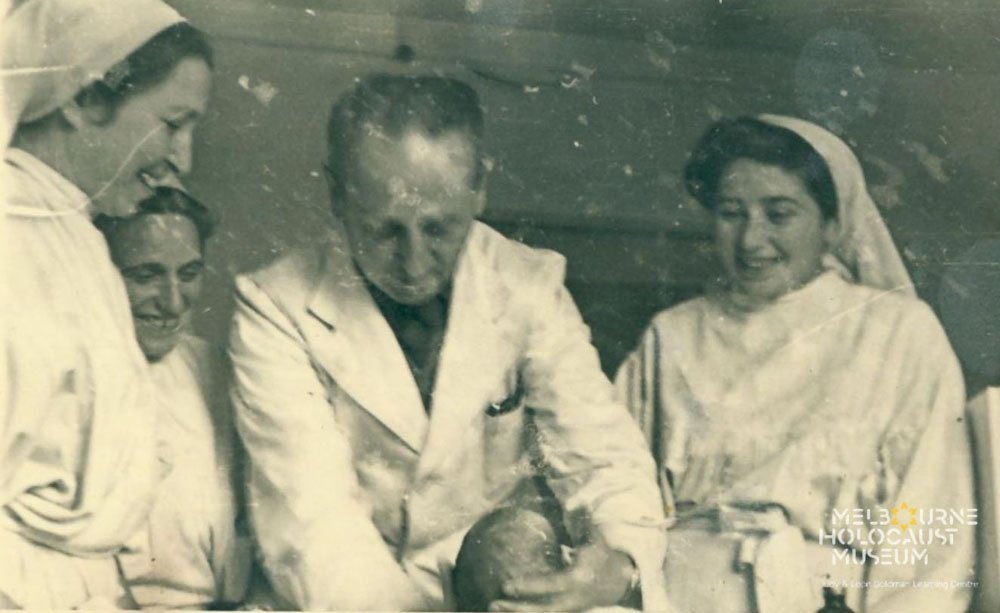
Dr Wasser and six members of his group travel first to Paris on September 3, 1946 and then on to Heidelberg[40] Cf. travel expense report, UNRRA-Archives, no. S-1523-0000-0025, pg 79f. on September 23, 1946 . The Australian group is now listed as UNRRA Team 160 and deployed in the Pocking DP camp[41] Jewish DP-Camps in Germany, Pocking page (German), retrieved May 8, 2023. south of Passau (Bavaria) . This second largest DP camp in Germany, with over 7,600 people, was located on the site of the former Kirchham satellite camp of the Flossenbürg concentration camp. Another internal UNRRA letter[42] UNRRA-Archives, no. S-1523-0000-0025, pg 104 und S-1381-0000-0041, pg 10. shows that the deployment of Team 160 ended in March 1947. However, the UNRRA documents on the Dr Wasser group do not reveal anything about the group’s specific tasks or the assessment of its performance.
As one of the two Germans in the team, Dr. Wasser remains in Germany. According to his family, he worked for the US military government’s Medical Director for Germany as head of the children’s health service from mid-1947. His duties included instructing the DP camps and the pediatricians, advising those working in childcare and communicating between the German doctors and the US military government.
After 10 years of separation to his family in Brazil
Dr. Wasser’s granddaughter Ursula explains why the family chose Brazil as their home in exile and settled in Rolândia[43] Wikipedia about Rolândia (German), retrieved on 9.11.2024., a town founded by German emigrants in the state of Paraná, almost 600 kilometers west of Sao Paulo: The Koch-Weser[44] Wikipedia about Erich Koch-Weser (1875 - 1944). The lawyer and former left-wing liberal Reich minister was forced out of his job by the Nazis in 1933 because of his Jewish mother. At the end of 1933, he moved with his family to Rolândia, a town founded by Germans. family known to the Wassers had already fled to Rolândia from the Nazis in 1933. Irma Koch-Weser had advised Annemarie Wasser to buy so-called land certificates[45] The land certificates issued by an English settlement company probably also helped Jewish refugees to avoid the “Reich Refugee Tax” and other extortionate demands for money by the Nazis. Cf. film info “Flucht in den Dschungel" (Escape to the jungle), retrieved on Nov 9, 2024.. This enabled them to prove land ownership, which made it easier to obtain a visa. The papers are later exchanged for a piece of virgin forest or farmland.
Annemarie and her daughters have lived there since 1939. Annemarie Wasser works as a domestic and agricultural employee. The daughters have since married; their families have children.
Ernst Wasser continues to make efforts to enter Brazil. In October 1948, he finally received permission[46] Military mission of Brazil in Germany, residence permit for Ernst Wasser dated 14.10.1948. for permanent residence. After almost ten years of separation, he travels to reunite with his wife Annemarie and daughters Brigitte and Anne Rose. The grandchildren born in Rolândia, including Anne Rose’s three-year-old daughter Ursula, are also eagerly awaiting his arrival.
At the time, Rolândia consisted of scattered and sometimes remote houses. For the children, the jungle with its noises and despite its many dangers is an adventure playground, Ursula remembers. They grew up with animals. Many neighbors can only be reached via footpaths and on horseback.


Left: On the road with a carriage at Rolandia: Dr. Wasser with daughter Anne Rose and grandson. Right: Taking a break while working in the fields: Dr. Wasser and a son-in-law. Photos: Welch archive.
Dr. Wasser is not officially allowed to practice in Rolândia either. However, he is happy to be on hand when a competent medical assistant is needed – for example during births. Anne Rose and Brigitte occasionally lend him a hand. However, it proves difficult to finance their living expenses from the farm. Dr. Wasser and his wife decide to return to Germany. Anne Rose and her family follow years later. Brigitte stays in Brazil, where she marries. Her six daughters found their future there.

Dr Ernst Wasser, ca. 1968, photo: Welch archive.
Back in Berlin
“Despite everything, he is a friend of Germany[47] Talk to U. Welch loc.cit.” and also puts up with tough debates with Jewish friends who do not want to set foot on German soil again at any price, Ursula recalls.
The Wasser couple returned to Germany in 1958. Dr. Wasser, already of retirement age, opened his paediatric practice in the West Berlin district of Onkel Toms Hütte (in today’s Steglitz Zehlendorf district) in the terraced house at Am Fuchspass number 4, which he ran until his final retirement in 1965. He also supports the Pastor-Braune-Haus[48] Homepage Pastor-Brauine-Haus (German), retrieved May 15, 2023., a home for disabled children in the Lankwitz district. From 1967, the West Berlin telephone directory lists a residential address in the Schöneberg district.
Dr. Ernst Ludwig Wasser dies in Berlin on October 4, 1969. His wife Annemarie dies on August 28, 1982. They are survived by two daughters, nine grandchildren and their families.
Dr Wasser’s fate is an example of the catastrophic losses caused by the National Socialist persecution of Jewish intellectuals. “More than half of the doctors working as paediatricians in 1933 were affected; the regime took away their profession, title, environment, dignity and, for many, their lives,” writes medical historian Prof. Dr phil. Eduard Seidler[49] Eduard Seidler, preface for "Jüdische Kinderärzte 1933 – 1945. Entrechtet – geflohen -ermordet", Freiburg 2014, retrieved April 23, 2023.. In 2000, he published the documentation “Jüdische Kinderärzte 1933 – 1945. Entrechtet – geflohen – ermordet” (Jewish pediatricians 1933 – 1945. Deprived of their rights – fled – murdered). The German Society for Pediatrics and Adolescent Medicine (DGKJ) maintains an online database[50] Database of the DGKJ with around 800 names of persecuted Jewish paediatricians. with information about the persecuted and murdered pediatricians. The entry there for Dr Wasser and the information that he too – like the author’s father – was a Dunera Boy inspired this article. Research in this database led to another Jewish paediatrician and Dunera Boy: Dr Hans Frankenstein from Görlitz also came to the Australian internment camps via the Kitchener Camp and with the Dunera.
Please Note: This article was originally based on Dr. Wasser’s biography from the DGKJ project mentioned above and further research. At the end of 2024, the text was expanded with a lot of information about the family, which Dr. Wasser’s granddaughter Ursula Welch shared. She also provided extensive photographic material and an audio file.
Footnotes
show
- [1]↑Birth entry no. 84 from March 28, 1893.
- [2]↑Registry office Charlottenburg, death entry no. 563 from Feb 21, 1920.
- [3]↑Registry office Charlottenburg, death entry no. 1872 from Seo 30, 1914.
- [4]↑Today a neighbourhood of Neustadt/Orla, Thuringia.
- [5]↑Birth entry no. 164 from Juli 4, 1890.
- [6]↑Cf. Mapping the Lives about Elfriede Wasser, retrieved May 12, 2023.
- [7]↑Cf. National Archives of Australia (NAA), NAA_ItemNumber9907366.
- [8]↑This medal is still in the family's possession today. Conversation with granddaughter Ursula Welch, 8.11.2024.
- [9]↑Cf. Information about the Wasser family on www.ancestry.de, retrieved April 18, 2023.
- [10]↑Adress book Berlin, 1920 edition.
- [11]↑Marriage entry Königstein/Taunus no. 21 from Sep 15, 1921.
- [12]↑Cf. Information about the Wasser family on www.ancestry.de, retrieved April 18, 2023.
- [13]↑Ibid.
- [14]↑Wikipedia about Pila, retrieved May 15, 2023.
- [15]↑White pages Berlin 1921 edition.
- [16]↑Cf. Charlotte Rink on Pila.pl, retrieved May 12, 2023.
- [17]↑Mapping the Lives about Ernst Wasser, retrieved May 12, 2023.
- [18]↑Wikipedia about Landwerk Neuendorf, retrieved May 12, 2023.
- [19]↑Gutshof mit Geschichte, retrieved June 17, 2023.
- [20]↑Mail of Sachsenhausen memorial to P. Dehn, from July 7, 2022.
- [21]↑Mapping the Lives loc.cit.
- [22]↑For the background and history of the Kitchener Camp, see Clare Ungerson "Four Thousand Lives. The Rescue of German Jewish Men to Britain, 1939". The History Press, Cheltenham 20014/2019.
- [23]↑Route sheet of the German Jewish Aid Committee for Dr. Wasser.
- [24]↑Index Card of Home Office via ancestry.de.
- [25]↑Heinz Dehn in the compensation proceedings before the Landgericht Berlin, file no. 191.0 (Entsch.) 421/74.
- [26]↑Cf. Paul R. Bartrop, Gabrielle Eisen „The Dunera Affair“, Melbourne 1990. Chapter 1 documents numerous documents on the negotiations with Australia.
- [27]↑Talk to Ursula Welch, loc.cit.
- [28]↑Christine Kanzler, Elisabeth Lebensaft in Australian newspapers, July 2021. Quoted from "Dunera News" Nr. 111, page 8.
- [29]↑The Sobieski, licensed for 940 passengers and 260 seamen, set sail for Canada from Liverpool on July 7, 1940 with 1,828 internees. The Duchess of York, the Arandora Star and the Ettrick were also overcrowded, in some cases by more than double.
- [30]↑Cf. file card Fritz Sternhell, NAA_ItemNumber8618440.
- [31]↑The fact that the internees were "permitted to volunteer" is documented by notes from the Australian General-Adjudant dated March 29, 1946 in NAA_ItemNumber4938132, sheet 28, number d.
- [32]↑The railways of the neighbouring states New South Wales and Victoria had different track gauges. Albury was the largest transhipment station in Australia.
- [33]↑Discharge documents Ernst Wasser, NAA_ItemNumber6244575, page 5.
- [34]↑UNRRA, founded in 1943 by 44 countries, looks after "Displaced Persons" (DP) - people who were deported to Germany by the Nazis from their home countries as forced laborers, concentration camp prisoners or prisoners of war. Up to 11 million of these stranded people were cared for and looked after in more than 700 camps at times until they could be repatriated to their home countries.
- [35]↑UNRRA-Archives, no. S-1373-0000-0019, page 86.
- [36]↑Cf. file Theodor Wolff, NAA_ItemNumber9907457.
- [37]↑Cf. UNRRA-Archives, no. S-1174-0000-0179-0001, S-1267-0000-0352, S-1381-0000-0041, S-1523-0000-0025.
- [38]↑Cf. UNRRA-Archives, no. S-1381-0000-0041, pg 56.
- [39]↑Dr. Wasser, letter from May 8, 1946, UNRRA-Archives, no. S-1381-0000-0041, pg 21.
- [40]↑Cf. travel expense report, UNRRA-Archives, no. S-1523-0000-0025, pg 79f.
- [41]↑Jewish DP-Camps in Germany, Pocking page (German), retrieved May 8, 2023.
- [42]↑UNRRA-Archives, no. S-1523-0000-0025, pg 104 und S-1381-0000-0041, pg 10.
- [43]↑Wikipedia about Rolândia (German), retrieved on 9.11.2024.
- [44]↑Wikipedia about Erich Koch-Weser (1875 - 1944). The lawyer and former left-wing liberal Reich minister was forced out of his job by the Nazis in 1933 because of his Jewish mother. At the end of 1933, he moved with his family to Rolândia, a town founded by Germans.
- [45]↑The land certificates issued by an English settlement company probably also helped Jewish refugees to avoid the “Reich Refugee Tax” and other extortionate demands for money by the Nazis. Cf. film info “Flucht in den Dschungel" (Escape to the jungle), retrieved on Nov 9, 2024.
- [46]↑Military mission of Brazil in Germany, residence permit for Ernst Wasser dated 14.10.1948.
- [47]↑Talk to U. Welch loc.cit.
- [48]↑Homepage Pastor-Brauine-Haus (German), retrieved May 15, 2023.
- [49]↑ Eduard Seidler, preface for "Jüdische Kinderärzte 1933 – 1945. Entrechtet – geflohen -ermordet", Freiburg 2014, retrieved April 23, 2023.
- [50]↑Database of the DGKJ with around 800 names of persecuted Jewish paediatricians.
